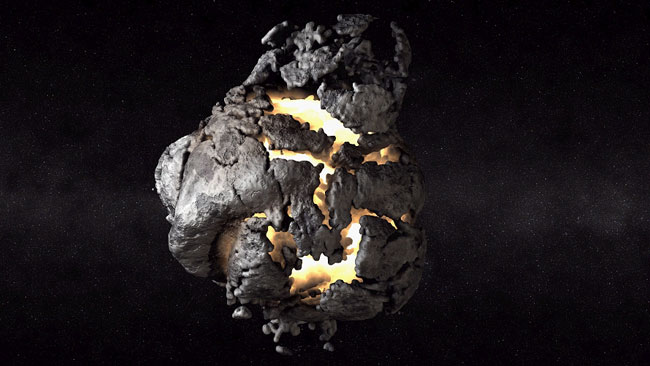A super-powerful computer has simulated what it might take to keep Earth safe from a menacing asteroid.
Researchers have utilized the number-crunching brainpower of Red Storm—a supercomputer at Sandia National Laboratories in Albuquerque, New Mexico. Red Storm, a Cray XT3 supercomputer, is the first computer to surpass the 1 terabyte-per-second performance mark—a measure that indicates the capacity of a network of processors to communicate with each other when dealing with the most complex situations—in both classified and unclassified realms.
The massively parallel computing simulations have modeled how much explosive power it would take to destroy or sidetrack an asteroid that’s got Earth in its cross-hairs.
>
>
The Red Storm computational output provided useful insights.
In particular, Boslough said, was the realization that using multiple, low-yield, deflecting explosions is much better than using one high-yield device.
"There are many advantages" to this approach, Boslough observed. "For one, you don’t need to rendezvous with the asteroid and drill a hole or otherwise place a devise. You can set it off as a surface burst. Contrast the time it takes to ‘land’ something on the surface of an asteroid—like NASA’s Near Earth Asteroid Rendezvous (NEAR) spacecraft—to how long it takes just to get there, like NASA’s Deep Impact," he said.
You want to solve the problem quickly, Boslough said, "even if we know about an impact decades in advance—the public perception will be that time is of the essence."
If asteroid deflection is the game plan, there’s need to avoid accidental breakage.
A low yield blast lessens the volume of material that is subjected to the highest tensile and shear stress, reducing the likelihood that the object will come apart.
"If you do break the asteroid, you want to make sure none of the big pieces hit the Earth," Boslough said. "Multiple low-yield bursts over an entire hemisphere [of the asteroid] would reduce the likelihood that anything big would get left behind on the impact trajectory."
Backup plan
The fact that you can get a low-yield device to a menacing object fast also means that you are more likely to have a second chance, Boslough noted. That equates to a viable "backup plan", he added, for other, more elaborate, expensive, and time-consuming methods.
"When you are saving the Earth, it’s good to have a plan B. I suspect that if a Near Earth Object (NEO) were confirmed to be on an impact trajectory, public opinion would demand fast action and this would become plan A, if it wasn’t already," Boslough said.
Boslough said that follow-on work regarding defending Earth from NEOs is slated. Specifically on tap is delving into momentum transfer for a variety of assumed asteroidal and cometary materials and structures.
Researchers have utilized the number-crunching brainpower of Red Storm—a supercomputer at Sandia National Laboratories in Albuquerque, New Mexico. Red Storm, a Cray XT3 supercomputer, is the first computer to surpass the 1 terabyte-per-second performance mark—a measure that indicates the capacity of a network of processors to communicate with each other when dealing with the most complex situations—in both classified and unclassified realms.
The massively parallel computing simulations have modeled how much explosive power it would take to destroy or sidetrack an asteroid that’s got Earth in its cross-hairs.
>
>
The Red Storm computational output provided useful insights.
In particular, Boslough said, was the realization that using multiple, low-yield, deflecting explosions is much better than using one high-yield device.
"There are many advantages" to this approach, Boslough observed. "For one, you don’t need to rendezvous with the asteroid and drill a hole or otherwise place a devise. You can set it off as a surface burst. Contrast the time it takes to ‘land’ something on the surface of an asteroid—like NASA’s Near Earth Asteroid Rendezvous (NEAR) spacecraft—to how long it takes just to get there, like NASA’s Deep Impact," he said.
You want to solve the problem quickly, Boslough said, "even if we know about an impact decades in advance—the public perception will be that time is of the essence."
If asteroid deflection is the game plan, there’s need to avoid accidental breakage.
A low yield blast lessens the volume of material that is subjected to the highest tensile and shear stress, reducing the likelihood that the object will come apart.
"If you do break the asteroid, you want to make sure none of the big pieces hit the Earth," Boslough said. "Multiple low-yield bursts over an entire hemisphere [of the asteroid] would reduce the likelihood that anything big would get left behind on the impact trajectory."
Backup plan
The fact that you can get a low-yield device to a menacing object fast also means that you are more likely to have a second chance, Boslough noted. That equates to a viable "backup plan", he added, for other, more elaborate, expensive, and time-consuming methods.
"When you are saving the Earth, it’s good to have a plan B. I suspect that if a Near Earth Object (NEO) were confirmed to be on an impact trajectory, public opinion would demand fast action and this would become plan A, if it wasn’t already," Boslough said.
Boslough said that follow-on work regarding defending Earth from NEOs is slated. Specifically on tap is delving into momentum transfer for a variety of assumed asteroidal and cometary materials and structures.



Comment